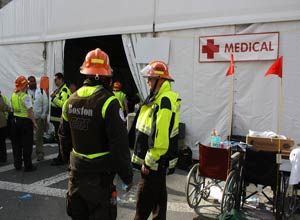BOSTON — EMS and emergency response chiefs outlined lessons to learn from the marathon bombings during a special webcast held in the aftermath of the tragedy.
Among the participants in the event — hosted by The Forum at Harvard School of Public Health — were Boston EMS Chief James Hooley, EMS Lt. Brian Pomodoro and Paul Biddinger, Chief of the Division of Emergency Preparedness at Massachusetts General Hospital.
In the webinar, Chief Hooley said that the main medical tent was at half-full capacity and the secondary tent was full prior to the first bomb going off.
“The day was unfolding like a lot of marathons in the past,” he said. Shortly after the first explosion, responders initially didn’t know it was a bomb and thought a vendor might have had an accidental explosion, he said.
“Then we heard the second explosion, which left no doubt, and we started responding.”
Lt. Pomodoro, who was serving as safety officer, described the response as “more instinct than scene size-up.”
“You can’t turn your head to hurt people,” he said. “That’s why bystanders kicked in, too.”
Biddinger said this mass group effort was life-saving for the victims, because there were so many medical personnel out in the field and volunteers providing tourniquets on wounds.
“Had they not had those interventions they would have died,” he said.
At the end of the presentation, Hooley gave advice for other EMS chiefs to train, equip personnel and have enough ambulances to be able to respond to an incident from muscle memory.
“You have to think that it’s going to happen — at the most innocuous place,” he said. “Be ready to imagine the unimaginable.”












